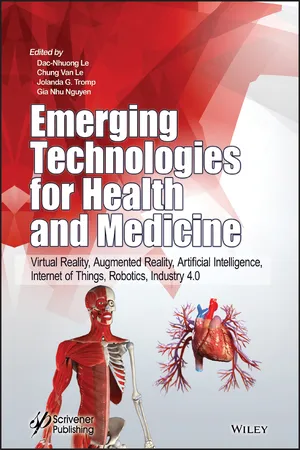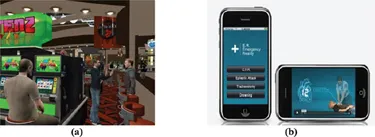
Emerging Technologies for Health and Medicine
Virtual Reality, Augmented Reality, Artificial Intelligence, Internet of Things, Robotics, Industry 4.0
- English
- ePUB (mobile friendly)
- Available on iOS & Android
Emerging Technologies for Health and Medicine
Virtual Reality, Augmented Reality, Artificial Intelligence, Internet of Things, Robotics, Industry 4.0
About this book
Showcases the latest trends in new virtual/augmented reality healthcare and medical applications and provides an overview of the economic, psychological, educational and organizational impacts of these new applications and how we work, teach, learn and provide care.
With the current advances in technology innovation, the field of medicine and healthcare is rapidly expanding and, as a result, many different areas of human health diagnostics, treatment and care are emerging. Wireless technology is getting faster and 5G mobile technology allows the Internet of Medical Things (IoMT) to greatly improve patient care and more effectively prevent illness from developing.
This book provides an overview and review of the current and anticipated changes in medicine and healthcare due to new technologies and faster communication between users and devices.
The groundbreaking book presents state-of-the-art chapters on many subjects including:
- A review of the implications of Virtual Reality (VR) and Augmented Reality (AR) healthcare applications
- A review of current augmenting dental care
- An overview of typical human-computer interaction (HCI) that can help inform the development of user interface designs and novel ways to evaluate human behavior to responses in VR and other new technologies
- A review of telemedicine technologies
- Building empathy in young children using augmented reality
- AI technologies for mobile health of stroke monitoring & rehabilitation robotics control
- Mobile doctor brain AI App
- An artificial intelligence mobile cloud computing tool
- Development of a robotic teaching aid for disabled children
- Training system design of lower limb rehabilitation robot based on virtual reality
Frequently asked questions
- Essential is ideal for learners and professionals who enjoy exploring a wide range of subjects. Access the Essential Library with 800,000+ trusted titles and best-sellers across business, personal growth, and the humanities. Includes unlimited reading time and Standard Read Aloud voice.
- Complete: Perfect for advanced learners and researchers needing full, unrestricted access. Unlock 1.4M+ books across hundreds of subjects, including academic and specialized titles. The Complete Plan also includes advanced features like Premium Read Aloud and Research Assistant.
Please note we cannot support devices running on iOS 13 and Android 7 or earlier. Learn more about using the app.
Information
Part I
VIRTUAL REALITY, AUGMENTED REALITY TECHNOLOGIES AND APPLICATIONS FOR HEALTH AND MEDICINE
CHAPTER 1
REVIEWS OF THE IMPLICATIONS OF VR/AR HEALTH CARE APPLICATIONS IN TERMS OF ORGANIZATIONAL AND SOCIETAL CHANGE
Abstract
1.1 Introduction


1.2 Virtual Reality and Augmented ...
Table of contents
- Cover
- Title page
- Copyright page
- List of Figures
- List of Tables
- Foreword
- Preface
- Acknowledgments
- Acronyms
- Part I: Virtual Reality, Augmented Reality Technologies and Applications For Health and Medicine
- Part II: Artificial Intelligence Technologies and Applications for Health and Medicine
- Part III: Robotics Technologies and Applications for Health and Medicine
- Part IV: Internet of Things Technologies and Applications for Health and Medicine
- End User License Agreement